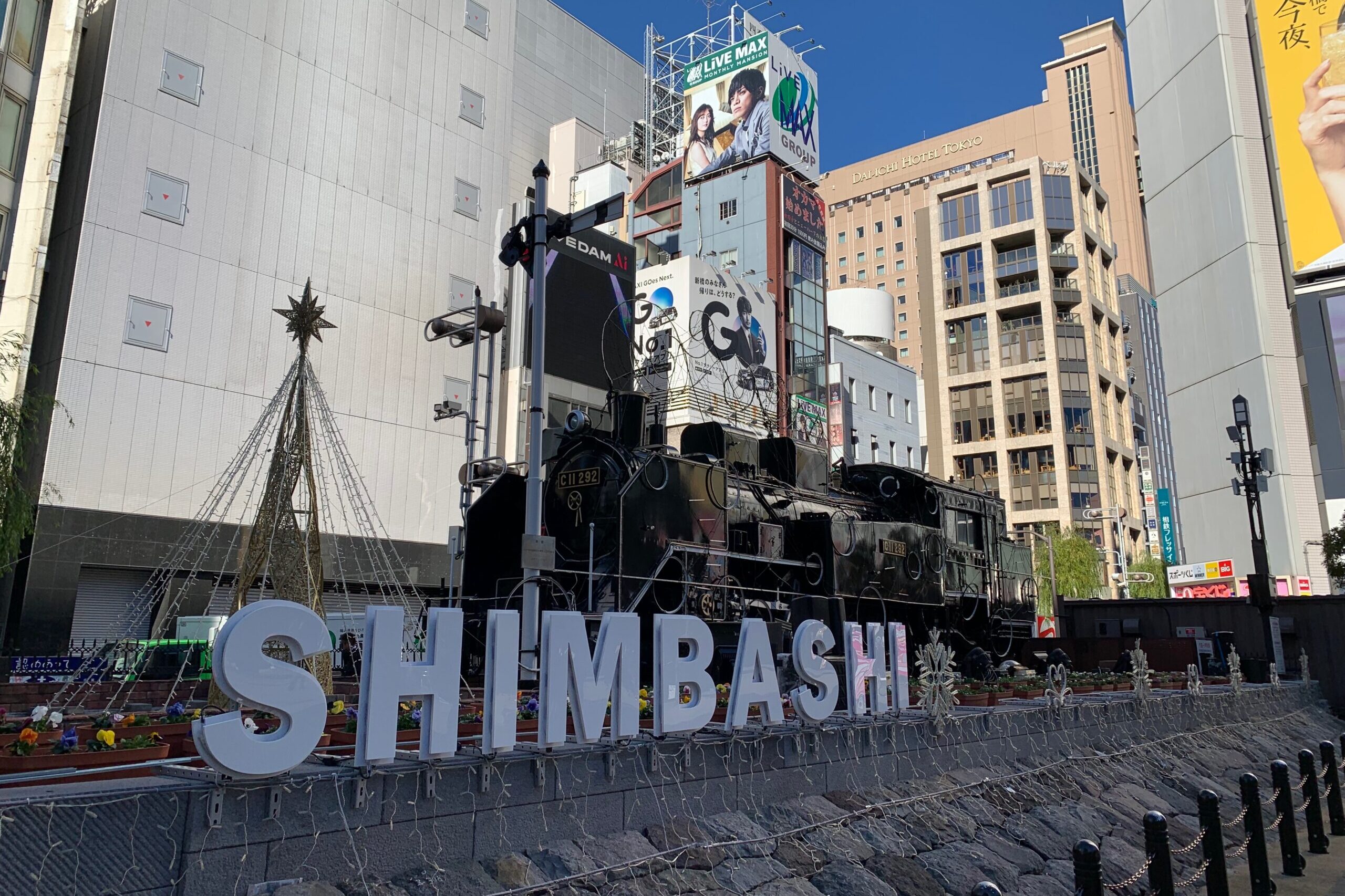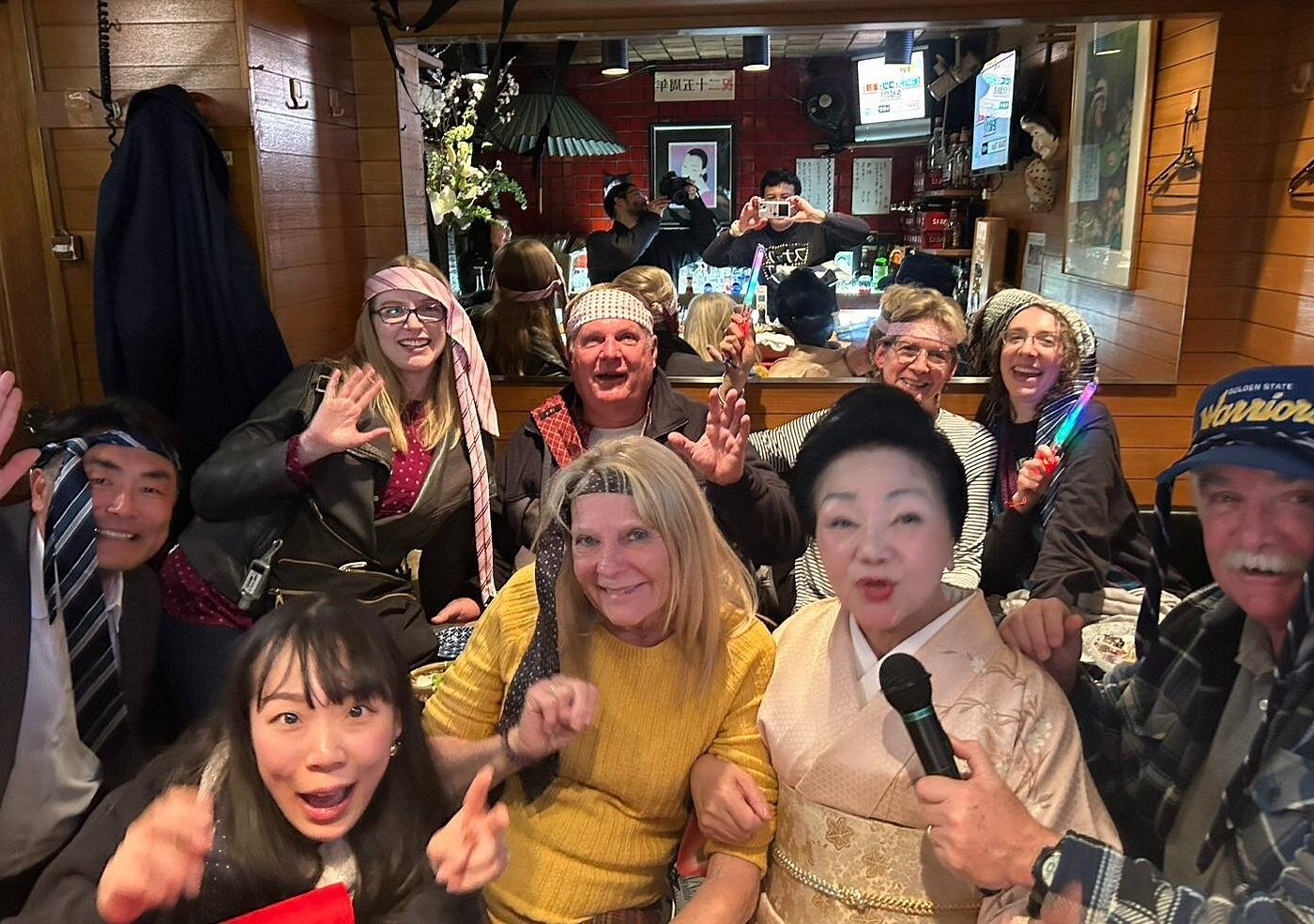
Having concluded its role as a broadcasting tower in 2018, it became Skytree’s backup. But the idea of Tokyo lacking a giant red tower in the center is unimaginable. During the day, it’s nice to gaze at the tower against the blue sky. However, at night, watching the lit-up tower floating in the night sky makes you feel you’re truly in Tokyo.
Tokyo Tower, may you be eternal!!
A. Start Walking from JR Hamamatsu-cho Station
Start from JR Hamamatsu-cho Station (marked as A on the map) on the JR Yamanote Line.
Exiting from the north exit of the station and descending to street level, you’ll catch sight of the iconic Red Giant Tokyo Tower. In this area, it’s hard to miss Tokyo Tower from any places, making it a landmark not just in the literal sense, but also in terms of geography. As you start walking towards Tokyo Tower, your first destination for the day awaits – Zojo-ji, where the Shoguns of the Edo period rest.

Detour Point ❶: Water Transportation between Hinode Pier and Asakusa
If you’re staying around Asakusa, trying out water transportation could be quite interesting. Tokyo used to be a city crisscrossed by waterways, with a well-developed water transport system. Unfortunately, it’s difficult to find traces of that today. However, from Asakusa to Hamamatsu-cho Station (Hinode Pier), there are relatively frequent boat services from around 10 am to 4 pm. It’s quite enjoyable to view the city of Tokyo from the river. The boats themselves range from futuristic designs to traditional ones, making the journey itself a memorable part of your travel.
B. First Gate to Shogun’s Temple Zojo-ji: Daimon
If you stroll down the main street towards Tokyo Tower, the first distinctive spot you’ll encounter, set against the backdrop of Tokyo Tower, is Daimon (marked as B on the map). This area takes its name from this gate and also serves as the official entrance to the expansive Zojo-ji Temple.


C. Middle-Gate: Sangedatsumon
A little further down the path, you’ll reach an even larger gate, Sangedatsumon (marked as C on the map). This gate, built in the early Edo period in 1622, is designated as an Important Cultural Property of Japan.
As you come this far, your eyes are naturally drawn towards the Tokyo Tower in the background rather than the gate in front. Its presence becomes more prominent.
D. Zojo-ji Main Hall: Daiden
In the early years of the Azuchi-Momoyama period around 1570, shortly after Tokugawa Ieyasu, who founded the Tokugawa Shogunate Regime, began to govern the Kanto region. He chose Zojo-ji (marked as D on the map)as the family temple for the Tokugawa clan in 1590. It was relocated to its current site in 1598.
Six Shoguns are laid to rest in this temple. Behind the main hall, there is a graveyard where the Shoguns are laid to rest, and visitors can explore and pay their respects.
Additionally, the main hall, which was destroyed during World War II, was reconstructed in 1974.


Detour Point ❷: Care Guardian Deities of Children
After visiting the Shogun’s graveyard, consider paying a visit to the nearby Care Guardian Deities of Children, a group of a thousand Jizo statues dedicated to the well-being and growth of children and grandchildren. This site was established by a women’s support group at Zozo-ji Temple, praying for the healthy development of their offspring. The striking scene features Jizo statues adorned with red hoods and windmills. Originally, it is said to commemorate the children who lost their lives during World War II.
Deture Point ❸: Artificial Valley, Momiji Valley
Along the way from Zojo-ji to Tokyo Tower, you’ll come across Momiji Valley, an artificial gorge nestled in the sloping terrain. This man-made valley features lush greenery, natural rock formations, and a flowing stream, complete with a 10-meter waterfall. If you have some time, taking a leisurely stroll around this area is highly recommended. Particularly during autumn when the leaves turn vibrant red, spending some moments here is a delightful suggestion.


E. Needless to say, Tokyo’s Landmark Tokyo Tower
While the Skytree may have surpassed it in height, Tokyo Tower (marked as E on the map) still remains a prominent landmark in Tokyo. Standing at a playful number of height; 333 meters, the tower reflects the whimsy of its creators. Just as one would visit the Eiffel Tower in Paris, Tokyo Tower is a must-visit when in Tokyo.
Against the clear blue sky, Tokyo Tower stands proudly. When it emerges in the night cityscape, it becomes a tower between reality and dreams.
Well, instead of stringing together hundreds of words, let’s go up Tokyo Tower.
It’s huge!
It’s amazing!
It’s cool!
PR Enjoy Past & Present Tokyo
Tokyo Tower & Zojoji Temple Tour (Includes Tokyo Tower Ticket) presented by Viator;
F. Highest Mountain in the Central Tokyo area, Atago Shrine
While you’re at Tokyo Tower, why not make a detour to the highest point in the heart of Tokyo? However, surrounded by towering skyscrapers, Atago Shrine (marked as F on the map), once a landmark in the area, now hides in the valleys between buildings.
By the way, take note of the main staircase, known as the Stairway to Success, still drawing the faith of many today.
In the Edo period, way back in 1634, the third Shogun Tokugawa Iemitsu, passing by this shrine, was enchanted by the plum blossoms at the top of the staircase. Moved by the moment, he decided to have someone pluck them for him while still on horseback. Despite the daunting stairs causing hesitation, a courageous samurai named Magaki Heikurou from the Shikoku domain fearlessly rode up and presented a twig of plum blossoms to the Shogun. Impressed by this daring act, the Shogun praised Magaki Heikurou as the Best Equestrian in Japan, and his name echoed throughout the country in a single day. In those times, earning recognition from the Shogun for martial skills was considered the highest honor a Samurai could achieve.
If you have any grand ambitions, perhaps taking a vow at this shrine could be a great idea!


Deture Point ❹ : Sacred place for Japanese Office Worker’s Team-building, Around Shinbashi SL Square
After visiting Atago Shrine, Shinbashi Station (marked as G on the map) would be a convenient choice for your return. It’s a pleasant walk of just under 20 minutes from Atago Shrine, passing through an area where Japan’s government offices are clustered.
By the way, Shinbashi is considered a sacred place for Japanese office workers. While many may be familiar, being a office worker in Japan entails adhering to a unique business culture, involving long working hours, loyalty to one’s company, and obedience to the company’s culture. Recognizing that this environment may not be everyone’s cup of tea, office workers often gather after work to engage in team-building activities over drinks. Shinbashi is often celebrated as the go-to spot for post-work socializing due to the ample casual Izakayas, Japanese-style pubs or taverns. Let’s enjoy casual Izakaya in Shinbashi and get a firsthand look at Japanese corporate culture.
Shinbashi Station (marked as G on the map) is on the JR Yamanote Line, Ginza (Metro) Line, Asakusa (Metro) Line, and more. Be mindful on your way back to avoid stepping on a Japanese office worker who may have had a bit too much to drink and ended up ‘submarining’ at the station. Cheers to a safe journey home!
PR Enjoy Ramen Adventure
Shinbashi Night Tour: Local Guide & Drinks at Snack Bars presented by Viator;

I dig Tokyo Tower, man. It’s massive and always proudly standing tall at the heart of the city. When the moon pops up on top of the tower, it’s like my wild side starts howling at it, you know? Keeping those feelings in check is just part of being a cool urban dog. So, how about someone picks up the tab for a drink on a night like that?






